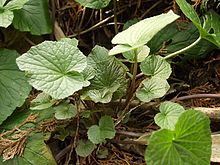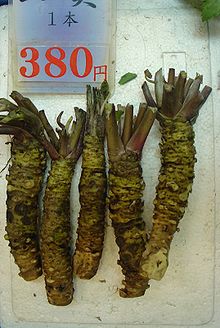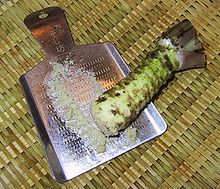 |
|
|
|
|
| Cuisines | Herbal | Spice | Curry | Yeast | Recipe | ||||||
|
Wasabi Wasabi (わさび(山葵)?, originally 和佐比; Wasabia japonica or Eutrema japonica), is a member of the Brassicaceae family, which includes cabbages, horseradish, and mustard. It is also called Japanese horseradish, although it is not actually from the horseradish species of plants. Its root is used as a condiment and has an extremely strong flavor. Its hotness is more akin to that of a hot mustard than that of the capsaicin in a chili pepper, producing vapours that stimulate the nasal passages more than the tongue. The plant grows naturally along stream beds in mountain river valleys in Japan. There are also other species used, such as W. koreana, and W. tetsuigi. The two main cultivars in the marketplace are W. japonica 'Daruma' and 'Mazuma', but there are many others. Uses Wasabi is generally sold either as a root which is very finely grated before use, as dried powder in large quantities, or as a ready-to-use paste in tubes similar to travel toothpaste tubes. In restaurants the paste is prepared when the customer orders, and is made using a grater to grate the root; once the paste is prepared, it loses flavor in 15 minutes. In sushi preparation, sushi chefs usually put the wasabi between the fish and the rice because covering wasabi until served preserves its flavor. Fresh wasabi leaves can be eaten, having the spicy flavor of wasabi roots. Because the burning sensations of wasabi are not oil-based, they are short-lived compared to the effects of chili peppers, and are washed away with more food or liquid. The sensation is felt primarily in the nasal passage and can be quite painful depending on amount taken. Legumes (peanuts, soybeans, or peas) may be roasted or fried, then coated with wasabi powder mixed with sugar, salt, or oil and eaten as a crunchy snack. Inhaling or sniffing wasabi vapor has an effect like smelling salts, a property exploited by researchers attempting to create a smoke alarm for the deaf. One deaf subject participating in a test of the prototype awoke within 10 seconds of wasabi vapor being sprayed into his sleeping chamber. This was "rewarded" with the 2011 Ig Nobel Prize in Chemistry to Makoto Imai, Naoki Urushihata, Hideki Tanemura, Yukinobu Tajima, Hideaki Goto, Koichiro Mizoguchi and Junichi Murakami for determining the ideal density of airborne wasabi (pungent horseradish) to wake people in event of an emergency. True wasabi and western wasabiWasabi is difficult to cultivate (see below), and that makes it quite expensive. Due to its high cost, a common substitute is a mixture of horseradish, mustard, starch and green food coloring. Outside of Japan, it is rare to find real wasabi plants. Often packages are labeled as wasabi, but the ingredients do not actually include wasabi plant. Although the taste is similar between wasabi and horseradish, they are easily distinguished. In Japan, horseradish is referred to as seiyō wasabi (西洋わさび?, "western wasabi"). In the United States, true wasabi is generally found only at specialty grocers and high-end restaurants. Chemistry The chemical in wasabi that provides for its initial pungency is the volatile allyl isothiocyanate, which is produced by hydrolysis of natural rhizome thioglucosides (conjugates of the sugar glucose, and sulfur-containing organic compounds); the hydrolysis reaction is catalyzed by myrosinase and occurs when the enzyme is released on cell rupture caused by maceration — e.g., grating — of the plant's rhizome. The unique flavor of wasabi is a result of complex chemical mixtures from the broken cells of the rhizome, including those resulting from the hydrolysis of thioglucosides into glucose and methylthioalkyl isothiocyanates. Research has shown that such isothiocyanates inhibit microbe growth, perhaps with implications for preserving food against spoilage and suppressing oral bacterial growth. PreparationWasabi is often grated with a metal oroshigane, but some prefer to use a more traditional tool made of dried sharkskin with fine skin on one side and coarse skin on the other. A hand-made grater with irregular teeth can also be used. If a shark-skin grater is unavailable, ceramic is usually preferred. |











